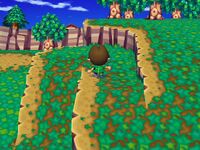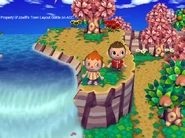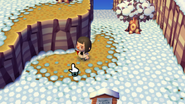No edit summary |
|||
| Line 22: | Line 22: | ||
[[File:999396_10201393479466591_1501765113_n.jpg|thumb|250px|Deterioration in {{NL}}.]] |
[[File:999396_10201393479466591_1501765113_n.jpg|thumb|250px|Deterioration in {{NL}}.]] |
||
In {{NL}}, it is reported that grass deterioration not only happens more slowly, but the damaged grass regrows faster. Also, when a [[Public Works Projects|Public Works Project]] has been completed and built, the grass under it will deteriorate instantly. The same effect happens with new player houses; if they are built and removed, the grass underneath it will be completely gone, leaving nothing but a big juicy patch of dirt. |
In {{NL}}, it is reported that grass deterioration not only happens more slowly, but the damaged grass regrows faster. Also, when a [[Public Works Projects|Public Works Project]] has been completed and built, the grass under it will deteriorate instantly. The same effect happens with new player houses; if they are built and removed, the grass underneath it will be completely gone, leaving nothing but a big juicy patch of dirt. |
||
| + | |||
| + | When a new town is made, it will start off with '''permanent''' patches of mud where grass deteriorates faster from, spreading throughout the map like paths. |
||
===Regrowing grass in New Leaf=== |
===Regrowing grass in New Leaf=== |
||
Revision as of 00:48, 2 August 2013
Template:Feature

This grass has been severely damaged by repeatedly running on it.
Grass Deterioration, also known as Animal Tracks (from the Japanese term けもの道), or Desire Lines is a feature introduced by City Folk. The game is able to keep track of the player's movements throughout town, and will wear down the grass accordingly.
Desertification, aside from being unappealing, can be a game-breaking issue, causing some Insects, such as the Dung Beetle, and Furniture, such as the Snowman Series, to be impossible to collect due to the loss of Snowballs.
In Animal Crossing: City Folk
How much grass is worn down depends on the current season and the player's speed when moving over the tile. All movement does damage, with running doing the most. Grass is most vulnerable during the Winter and most resilient during the Spring and Summer. Each time the town is loaded, the grass is worn down once more.
This feature was originally intended to create paths in frequently-traversed areas, which would add to the town’s own unique character. However, in many instances the feature has run amok, almost completely obliterating all the grass in an entire town, especially when players are chasing after insects such as Banded Dragonflies or Giant Petaltails.
Prevention
In City Folk, using hacks is the only way to completely prevent any grass deterioration as all player movement wears down grass. Players can still take certain steps to stem desertification, such as by moving slower, reducing the number of times they load a town each day, and walking only along designated paths to limit wear to only those areas. Placing designs on the ground will not protect the tile, but can demarcate paths to follow consistently. Planting flowers can also prevent deterioration, as tiles with flowers will not be worn down if they are stepped on only once daily.
Repair
Grass grows fastest in June, and slowest in December. Without being stepped on, it can take six months for grass to fully regrow, or one month if there is a healthy flower on a tile which is stepped on no more than once a day. Trees will also hasten the recovery rate by three times, as well as providing a physical barrier to prevent that particular tile from being trampled. Grass only recovers on days that the player loads the town--skipping time ahead by six months will not result in six months' worth of growth, and going backwards in time does not result in additional growth. Players should walk slowly if they must go over a recovering tile.
Petition
There is an online petition requesting that Nintendo release a patch over the Wi-Fi connection that will fix the grass growth issue. It should be noted that due to the software and hardware designs of the Wii, it may be impossible for Nintendo to fix the issue through a patch alone.
In Animal Crossing: New Leaf

Deterioration in New Leaf.
In New Leaf, it is reported that grass deterioration not only happens more slowly, but the damaged grass regrows faster. Also, when a Public Works Project has been completed and built, the grass under it will deteriorate instantly. The same effect happens with new player houses; if they are built and removed, the grass underneath it will be completely gone, leaving nothing but a big juicy patch of dirt.
When a new town is made, it will start off with permanent patches of mud where grass deteriorates faster from, spreading throughout the map like paths.
Regrowing grass in New Leaf
- Fertilizer and the Beautiful Town ordinance do not help regrow grass.
- Placing patterns on the ground will not prevent grass deterioration.
- Staying off the grass all together will help it slowly regrow.
- Watering flowers on decaying grass doubles the regrowth speed (the flowers must be watered for this to count). Stepping or walking over the flowers cancels this and will instead count as you walked on the grass, deteriorating it instead.
- Villagers walking on grass or watered flowers does not deteriorate it.
- Growing bushes or trees help regrowing grass on the tile they are planted on.
- Time traveling forward in time does not help grass regrow. The player must load up the save file once a day for it to register. If the player went a month forward in time, the grass would register it as if only one day passed.
- Rain and snow regrows grass slowly. However, as mentioned above, whatever grass is stepped on will cancel its regrowth and will decay instead.
Gallery
| Plants | ||
|---|---|---|
| ||
| Geography | ||
|---|---|---|
| ||





